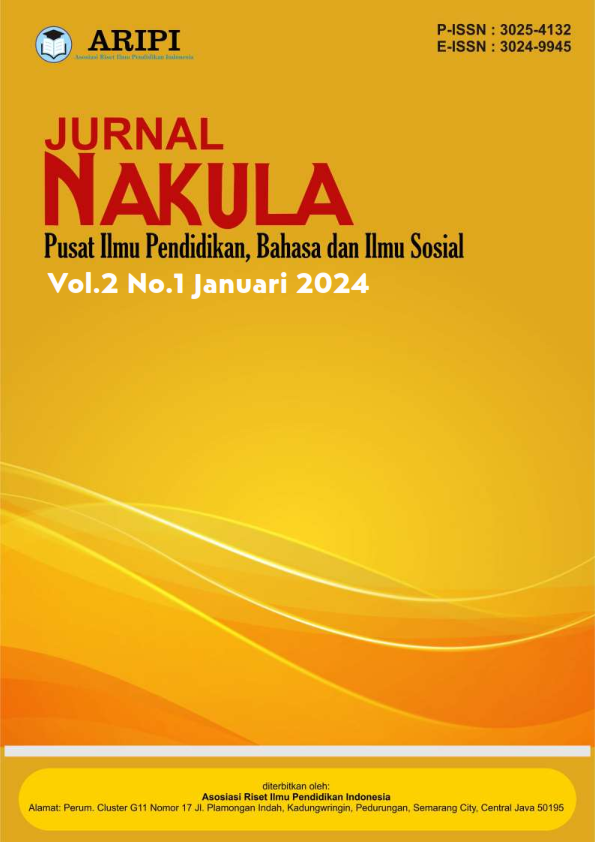Analisis Ujaran Kebencian Pada Kolom Komentar Akun Tiktok Maayang.Lucyana
DOI:
https://doi.org/10.61132/nakula.v2i1.398Keywords:
hate speech, tiktok social media, technologyAbstract
Hate speech is no stranger to us. Hate speech has existed in traditional media before the development of technology as it is now. The type of research used is qualitative with a descriptive method which aims to describe the illocutionary speech acts of hate speech in the comments column on Maayang.Lucyana's Tiktok social network. The data in this study are in the form of words and sentences of Indonesian netizens which are hate speech and are thrown against Mayang in the Tiktok comments column. The data source in this study is Tiktok social media which can be accessed by all parties, in the form of text taken through online searches in the Tiktok Maayang.Lucyana comments column. The data collection technique is obtained from the results of observing and analyzing the evidence of language crimes in the form of hate speech on Indonesian netizens in the comments column on Maayang.Lucyana's Tiktok account. The results of the study reveal that there are expressive, directive, and declarative types of illocutionary speech acts.
Downloads
References
Af’al, Wihdatul. 2022. Ujaran Kebencian Terhadap Aktor Arya Saloka di Media Sosial Twitter: Kajian Linguistik Forensik. Jurnal Sinestesia, 12(2), 435-444.
Arifianto, S., & Kusumasari, D. 2019. Makna Teks Ujaran Kebencian pada Media Sosial. Jurnal Komunikasi. Vol. 12, No. 1, hal: 1-15.
Claudia, Vinsca Sabrina, & Bagus Juniarto Wibowo. 2021. Ujaran Kebencian Warganet Pada Akun Instagram BWF (Badminton World Federation): Analisis Linguistik Forensik. Translation and Linguistics (transling), 1(1), 1-7.
Hildawati. 2018. Haters di Instagram: Antara Meluapkan Kebencian dan Memperoleh Keuntungan. Etnosia: Jurnal Etnografi Indonesia, 3(1), 22- 47.
Lubis, M. A., Azizan, N., & Ikawati, E. 2020. Kajian Gender dan Anak. Jurnal Kajian Gender dan Anak, 04(1), 63-82.
Maksudi, B. I., & Ratnamulyani, I. A. 2018. Peran Media Sosial dalam Peningkatan Partisipasi Pemilih Pemula di Kalangan Pelajar di Kabupaten Bogor. Jurnal Ilmu-ilmu Sosial dan Humaniora. Vol. 20, No. 2. hal: 154-161.
Purbohastuti, Arum Wahyuni. 2017. Efektifitas Media Sosial sebagai Media Promosi. Jurnal Tirtayasa Ekonomika. Vol. 12, No. 2, hal: 212-231.
S, F. R. 2021. Ujaran Kebencian Netizen Indonesia dalam Kolom Komentar Instagram Selebgram Indonesia: Sebuah Kajian Linguistik Forensik. AKSARA: Jurnal Bahasa dan Sastra, 22(1), 1-19. https://doi.org/10.23960/aksara/v22il.ppl-19
Shaleh, M. N. I., & Madhani, L. M., & Sari, I. N. B. 2021. Dampak Penggunaan Media Sosial Tiktok Terhadap Perilaku Islami Mahasiswa di Yogyakarta. Jurnal AT- Thullab. Vol. 3, No. 1, hal: 604-624.
Sholihatin, E. 2019. Linguistik Forensik dan Kejahatan Berbahasa. Yogyakarta: Pustaka Pelajar.
Suryani, Y., & Istianingrum, R., & Hanik, S. U. 2021. Linguistik Forensik Ujaran Kebencian Terhadap Artis Aurel Hermansyah di Media Sosial Intagram. Jurnal Ilmiah Program Studi Pendidikan Bahasa & Sastra Indonesia. Vol. 6, No. 1, hal: 107-118.
Syarif, E. 2020. Pengaruh Media Sosial Terhadap Sikap dan Pendapat Pemuda Mengenai Ujaran Kebencian. Jurnal Common, 3(2), 120-141.
Downloads
Published
How to Cite
Issue
Section
License
Copyright (c) 2023 Jurnal Nakula : Pusat Ilmu Pendidikan, Bahasa dan Ilmu Sosial

This work is licensed under a Creative Commons Attribution-ShareAlike 4.0 International License.





